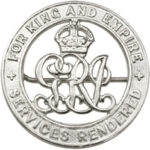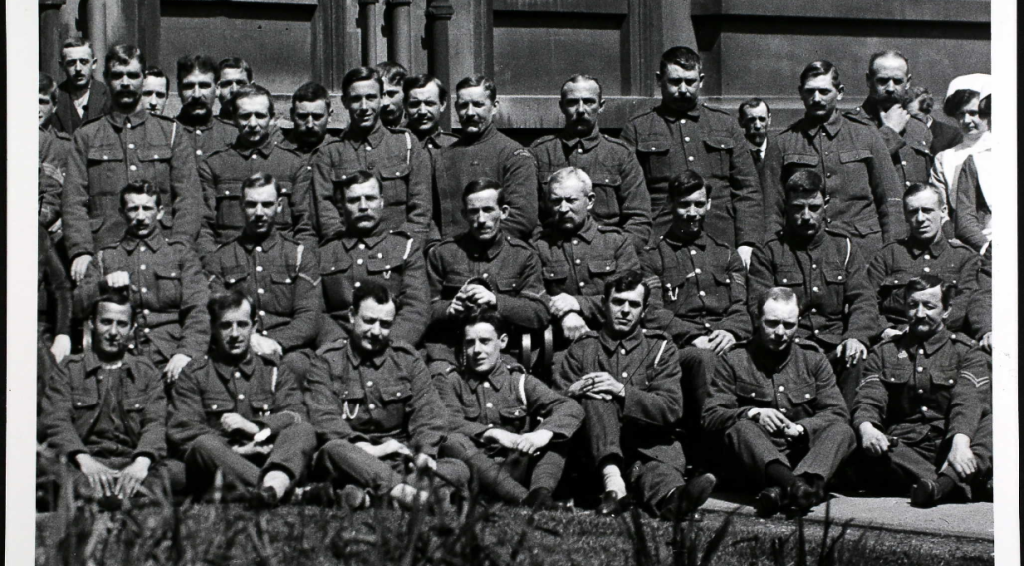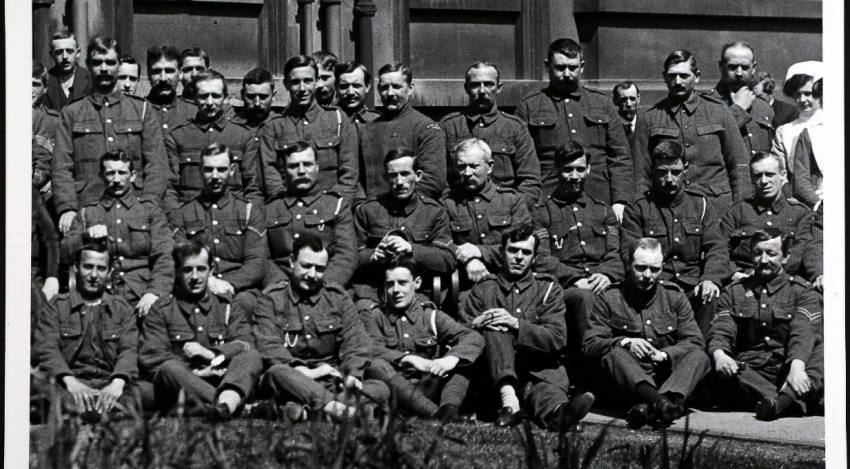There is an increasing number of people starting to take a real interest in tracing their military ancestors. And who wouldn’t want to discover a war hero in their family? They fought for our freedom, after all.
It is a sad fact that it is often easier to trace a relative from the First World War because of the great loss of British life this conflict caused. It touched almost every family back in Blighty — it is highly likely that you’ll have military connections in your family tree.
If your ancestor was a casualty of the First World War their death will most likely be recorded with the details of his military unit, date of death and location of burial or commemoration which is why researching war graves and memorials can be a great starting point for your genealogy research, especially if you have limited information. You can then work backwards and start to trace their military involvement by searching other records like rolls of honour and memorial registers that we hold on our site.
Commemorating the lost generation
When Britain went to war in August 1914 the huge scale of casualties that would follow was unimaginable. On the battlefield, the treatment of the dead had changed in the many years since the Battle of Waterloo. Then, the dead were buried in huge ‘bone pits’, with only the occasional officer being given individual graves. Within decades even these mass graves had been sold and desecrated, with the bones being used for fertiliser and teeth for dentures among the working-class of Victoria Britain.
As that century passed on, the Crimean and Boer War had both seen ordinary soldiers properly and individually buried, and it was with that approach in mind that the British Army entered the battlefield in 1914.
In those early months of the conflict, soldiers were either buried in slit trenches where they had fallen or removed for burial in existing civil graveyards where there was already consecrated ground. The recording of these burial sites was haphazard. Army Padres carried notebooks in which they were required to note down information on war graves and sent it to the War Office.
Much of this early information was often lost or incorrect, but by 1916 there were Divisional Burial Officers and later Graves Registration Units (GRU), which were charged with the proper burial of the fallen from the British Armed Forces. These men constructed battlefield cemeteries and built temporary, often hastily made, battlefield graves more permanent and registered them properly.
The (IWGC) Imperial War Graves Commission was formed under Royal Charter in 1917. While the conflict was still raging the Allied nations on whose national; soil the conflict was being fought gave land ‘in perpetuity’ for British War cemeteries.
Furthermore, the task of the IWGC was to work with the GRU’s and ensure that cemeteries were made permanent, names recorded and information on the dead gathered for future commemoration purposes. It centralised the care of the dead and when the war was over the IWGC was charged with the permanent preservation and care of the war cemeteries.
With so many dead, scattered far and wide, it was decided to close the majority of cemeteries and create large so-called ‘concentration cemeteries’, where the dead from a very wide area would be buried. Tyne Cot Cemetery in Flanders became the greatest of these, when over 11,000 burials were moved in during the 1920’s, creating what remains the largest British War cemetery in the world. Wooden crosses were replaced with stone headstones.
The starting point for tracing the dead from WWI is one of the first publications produced listing the dead: ‘Soldiers Died in the Great War‘, stated by HMSO in 1919 (Search this collection within Forces War records) Originally there were over 80 volumes, with a separate one for officers. The original soldiers were listed by regiment or corps, and using information culled from their service records. These records were painstakingly transcribed from the original 80 volumes by Forces War Records who strive to make your searches both efficient and fruitful. Records in this collection are likely to include the following:
- Name
- Birthplace
- Enlistment place
- Town of Residence
- Regimental Number
- gallantry awards
- rank
- Regiment
- Battalion
- Type of casualty
- Death date
- place and theatre of war.
The vast amount of information gathered by the IWGC in the inter-war period was eventually complied into the Cemetery and Memorial Registers published for over 2,000 cemeteries along the western front.
Aside from tracing where an ancestor is commemorated or buried, you can use the ‘WW1 Troop Movements and ORBATS’ interactive map to track the progress of units throughout the course of the First World War. With this feature you are able to determine exactly where units were on a given date and the battle, action or event they took part in that it will provide an insight into the movements and actions of your ancestor.
With such a huge casualty roll, the desire to remember the dead not just in stone, but also in print, started in the early months of the War. Publications like The Sphere, The Graphic and The Illustrated London News started carrying obituaries with photos to commemorate the war dead.
However, the people who bought these magazines were usually wealthy and the men featured in them were usually senior officers.
At first information on the fallen was divided between various publications until a former officer, Colonel LA Clutterbuck, began to work on ‘The Bond of Sacrifice’. This document aimed to list all the officers who died along with a short biography and photo. However, this wasn’t an official publication and lack of funds along with an increasing casualty list caused the ambitious task to be abandoned in 1915.
You can find ordinary soldiers in this roll of honour but some entries are brief because the amount paid dictated the length of the entry. This was different in that it included everyone from Private to Field Marshall, but it too relied on payments and also became an impossible task to complete.
In its final form The Roll of Honour records the biographies of more than 25,000 men from the British army, navy and air force, with nearly 7000 of the entries being accompanied by a photograph.
This is only a tiny fraction of the soldiers who died in the Great War, but is still a tribute to those who compiled it, and those who feature in it, and they are still a useful resource. You won’t find memorial volumes like these in one main archive. The Imperial War Museum has a good collection as does Forces War Records within the ‘Historic Document’ library and you can search easily with just a name. However, don’t be surprised if you don’t find an ancestor, as these sources are far from complete – most required a payment for a soldier to be included, and few could afford it.
Service Records and Medal Cards
Service Records follow the career of the individual, but don’t always have extensive information like you might think. Many records will be handwritten and have annotations from the serviceman/woman themselves or a dependents enquiry, therefore whilst very interesting per se, the general legibility of some records is poor.
However, service records are often the only place where family details, age, birthplace and former occupations are recorded.
Researching military records can be a daunting task and this is not helped thanks to the various physical locations where the records are stored in the UK. Many World War One records were also destroyed by the war department in the 1930s when they were put into limited storage and yet more got wrecked in the Blitz of 1940.
Pre-World War One and records up to 1920 are held at the National Archives in Kew, London and are available to view there. Records for medals issued during the First World War were also kept and were not damaged by the Blitz bombing. Medal Index Cards can be viewed at Forces War Records.
Medal Index Cards will give details of their regiment(s), unit(s), rank their Service Number. Once you know your relative’s regiment, chances are there’ll be a regimental or regional museum that may give more details about the movements of the regiment, and potentially retain Unit diaries and photos from that time that will help give an idea of the experiences your relative may have gone through. The regional library, meanwhile, may have contemporary news reports archived giving accounts of particular heroics by troops in the regiment, while the library in your relative’s hometown might well detail the local dead, wounded or missing, and explain what family they left behind.
Casualty lists
At the start of the First World War, it was decided to publish casualty list for soldiers who were reported killed, died of wounds or accident, been declared as missing, wounded or admitted to hospital with shell-shock. The ‘Daily War Office Casualty Lists’ were first published on 1st September 1914 and printed within various newspapers such as The Times, Daily Telegraph, The Irish Times and The Scotsman until August 1917. In August, it was decided that newspapers would no longer be able to print the casualty list in full due to the shortage of paper. Instead, the Daily Casualty List were published as the ‘Weekly Casualty List’ by His Majesty’s Stationery Office. Forces War Records has now transcribed all the records published within The Daily Telegraph Newspaper and we are very proud to be working with the National Library of Scotland to transcribe their original collection of the ‘Weekly Casualty List by His Majesty’s Stationery Office’. These records are of enormous value to researchers, for in many cases the information that a man appeared in a list will not be available elsewhere. Search this collection HERE.
Gallantry awards
In addition to the campaign medals (the 1914 Star, the 1914-15 Star, the British War Medal and the Victory Medal) the exceptional bravery of some people was recognised by gallantry awards such as the Victoria Cross and Military Medal. Search for your ancestor in the Forces War Records – Gazetted Awards and Mentions in Despatches collection.
Silver War Badge

Many injured soldiers returned to the Front line, but those discharged because of their wounds were awarded a Silver War Badge (TNA reference WO 329). Search for your ancestor in the Forces War Records – Silver War Badge List 1914-1918 collection.
Researching a War Memorial.
The first war memorial appeared in British towns and villages in 1918 and it is estimated that there are around 100,000 war memorials in the UK. Committees were formed to compile what was needed to list the local dead, and in some cases these records survive in county records offices or large local history libraries. Not only can this provide interesting information on community and social attitudes and beliefs at the time. The Imperial War Museum’s War Memorial Archive has complied a very comprehensive records of all war memorials in the UK, and worth checking their website to see if records about the war memorial you are researching are held. Records can include details of its design, construction, unveiling and its maintenance history. You can search the Forces War Records collection – WWI & WWII, Commonwealth War Graves Commission Death Registers for further details.
If you need any help with your research or have hit a brick wall then don’t hesitate to contact one of our experts via our support centre.
Get over the hurdles in your research, consider the unconsidered.
Discover interesting facts about your ancestors, become more knowledgeable about history, and reveal some of the fantastic characters involved in war…What are you waiting for?



